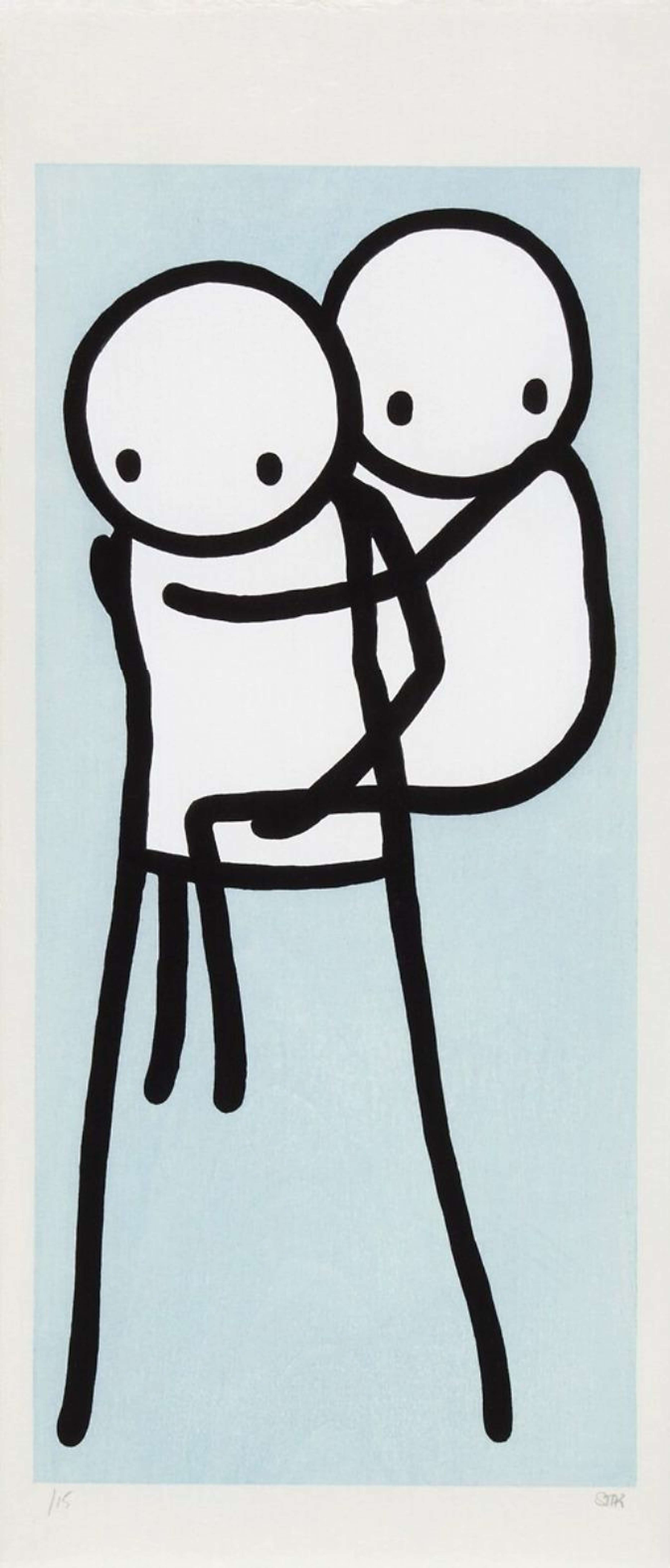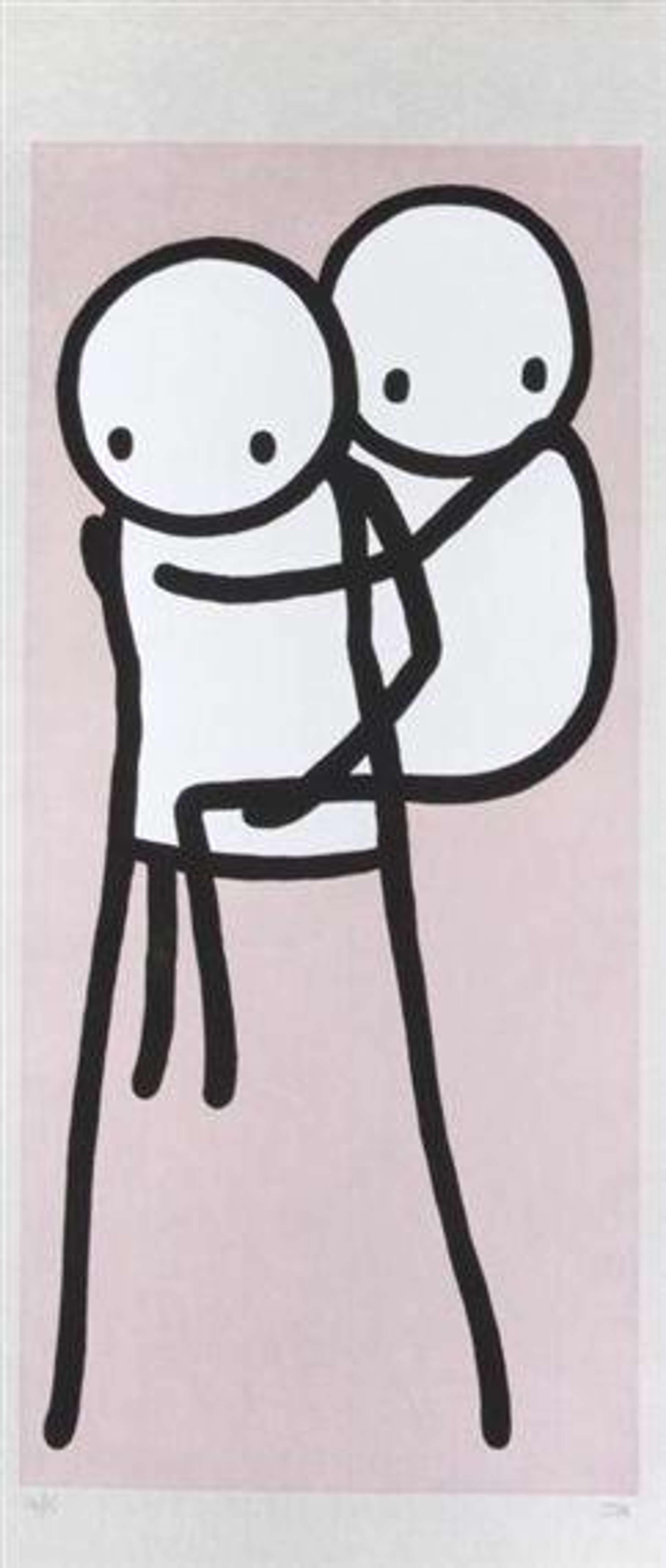 Onbu (blue) © Stik, 2013
Onbu (blue) © Stik, 2013
Stik
55 works
The series flaunts the influence of Japanese ukiyo-e prints on Stik's oeuvre.
 Onbu (grey) © Stik, 2013
Onbu (grey) © Stik, 2013When creating his Onbu series, Stik adhered to the style underpinning the traditional genre of 'ukiyo-e'. Translated as 'pictures in a floating world', ukiyo-e woodcuts are characterised flat colour and bold line. In this, the traditioanl Japanese style aligned perfectly with Stik's simple and graphic approach.
The principle of ukiyo-e aligns with Stik's typical subject matter.
 Lovers (blue) © Stik, 2011
Lovers (blue) © Stik, 2011The subject of the series, two embracing figures, is something which appears again and again in Stik's oeuvre. His works which focus on more than one of his iconic six-line figures are about togetherness and the power of human relationships. Stik explained his work as an attempt to "articulate the persistence of community, but also its frailty. I think that comes across in a lot of my pieces: the persistence of the vulnerable, and the melancholy of hope and tenacity."
The series was produced in the Adachi Institute in Tokyo.
 Onbu (pink) © Stik, 2013
Onbu (pink) © Stik, 2013The series was printed at the Adachi Institute in Tokyo, which was founded to preserve the Japanese tradition of woodcut printing. Stik's Onbu therefore marries new and old, and expresses Stik's respect for the tradition of printmaking.
Stik's six-line figures are inspired by Japanese Kanji.
 Deep (teal) © Stik, 2011
Deep (teal) © Stik, 2011Produced with only six-lines, Stik's iconic figures have an almost calligraphic quality to them. The street artist was allegedly inspired by the mark-making of kanji when conceptualising his stick figures, a logographic set of characters used in the Japanese writing system.
The series is inspired by a woodcut series by Utagawa Hiroshige.
 Onbu (blue) © Stik, 2013
Onbu (blue) © Stik, 2013Stik's Onbu, otherwise known as Piggyback, was derived from a 19th century woodcut series by Utagawa Hiroshige. Stik's composition reinterprets figures from Hiroshige's The Fifty-Three Stations of the Tokaido Road, and simplifies them to simple lines and dots.
David Hockney, too, found inspiration in Hiroshige’s work, particularly in his 1973 suite, The Weather Series. Hockney’s fascination with Japanese art and culture is evident throughout this series, which references the Ukiyo-e style and pays homage to Japanese masters like Hokusai and Hiroshige. Specifically, Hiroshige’s influence is apparent in Hockney’s Snow and Snow Without Colour, which echo the subtle elegance and compositional balance of traditional Japanese woodblock prints.
The series was made in collaboration with the Hiroshige Museum in Tokyo.
 Sleeping Baby © Stik, 2015
Sleeping Baby © Stik, 2015Made in collaboration with the Hiroshige Museum, the series is testament to Stik's enduring fascination with Japanese printmaking. The series reduces Hiroshige's original figures to their most basic forms, displaying not only Stik's distinctive style, but also the evolution of representation over the centuries.
Stik lived in Japan for a year when he was 19-years-old.
 Onbu (green) © Stik, 2013
Onbu (green) © Stik, 2013At the age of 19, Stik moved to Japan for a year and developed the style that characterises his public and private works today. The artist remarked on his formative time in Japan: "I lived in Japan for almost a year in my late teens and picked up this style of drawing, which is closely connected to writing as a shorthand for conveying emotion. It developed from there."
The background colours in Onbu are uncharacteristically muted.
 The Big Issue (red) © Stik, 2013
The Big Issue (red) © Stik, 2013Unlike many of Stik's other series, like The Big Issue and Sleeping Baby, Onbu is executed in a more muted colour palette. As opposed to the punchy primary coloured backgrounds he usually chooses, the background in Onbu are pastel shades of pink, grey, blue, and green. This subdued palette is an homage to the ukiyo-e woodcuts that inspired the series, while retaining Stik's distinct style.
Onbu is reminiscent of Stik's Big Mother mural.
 Single Mother © Stik, 2011
Single Mother © Stik, 2011The tender interaction depicted in Onbu is reminiscent of Stik's monumental mural Big Mother, executed in 2014. Painted on the side of a London tower block, the endearing image represents the community living within the apartment block, which has since been demolished.
The woodcut process of printing compliments Stik's style.
 Walk (yellow) © Stik, 2012
Walk (yellow) © Stik, 2012In his simplified and reductive approach to the human figure, Stik created a distinctive character that could be rendered with just six strokes of his spray paint canister, and two dots for the eyes. This graphic design lends itself perfectly to the printing technique of woodcut, which requires an initial drawing to be made before it is carved into a block, and then covered with ink to produce a monochromatic print.

